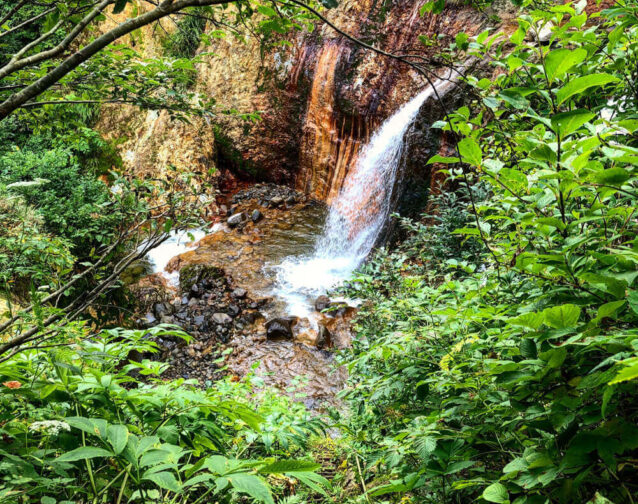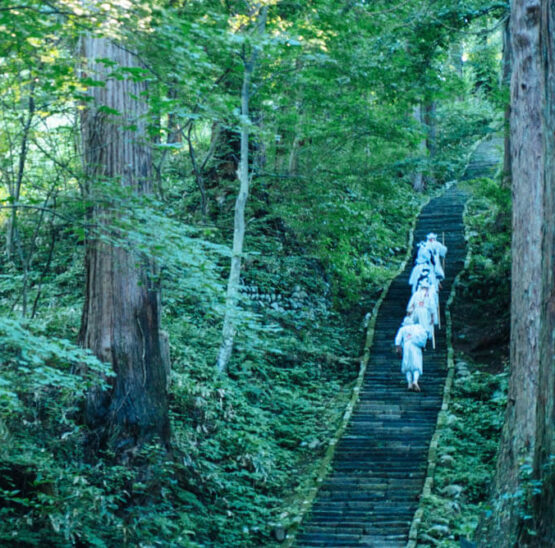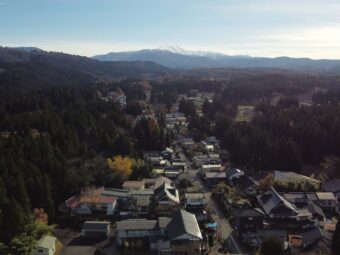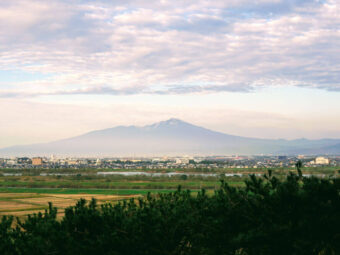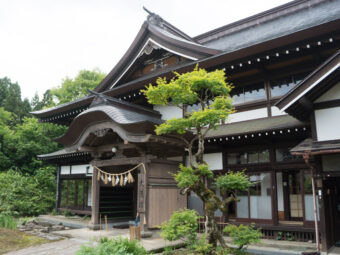YUDONO-SAN
Your
Rebirth
The secluded Mt. Yudono is home to one of the most mystical natural features in Japan, so mystical, in fact, that it is forbidden to even mention. After venturing to Mt. Haguro and Mt. Gassan on the Dewa Sanzan Journey of Rebirth, the final stop is Mt. Yudono, also known as Oku-no-in, the temple of the deep, where we are reborn.
Honji Buddha: Vairocana
(Dainichi Nyorai)
Supreme Buddha of the Cosmos
Shinto Manifestations:
Oyamatsumi-no-Mikoto, Deity of Mt. Yudono
Onamauchi-no-Mikoto, Deity of the land
Sukunahikona-no-Mikoto, Deity of Medicine
Cosmic Time: The Future
Height: 1503m (4931 ft.)
Open: Golden Week in May to end of October
The Shrine Gates of Mt. Yudono Shrine
Houses on the way up to Mt. Yudono
Encounter your Future Self
The main feature of Mt. Yudono is not the peak itself, but rather the object of worship found in Mt. Yudono Shrine. Mt. Yudono Shrine is not a typical shrine as the object of worship cannot be confined within a building. Although we are forbidden to talk about the object of worship, it can be said that this is where we are reborn, and where we come face-to-face with our future selves on the pilgrimage of rebirth.
Sokushinbutsu Buddha Mummies Training Ground
In the Shingon sect of Esoteric Buddhism, it was believed that it was possible to become one with Vairocana, the Supreme Buddha of the Cosmos (Dainichi Nyorai), through rigorous ascetic training and self-mummification. Of the 16 Sokushinbutsu (lit. Buddhahood in this very body) Buddha Mummies, or Living Buddha, in Japan, ten are said to have undertaken ascetic training, on Mt. Yudono such as at Churenji and Dainichibo temples.
The gates of Mt. Yudono in autumn
What to see on Mt. Yudono
Dragon statue in front of the gates of Mt. Yudono Shrine
Mt. Yudono Shrine
Speak not. Ask not. The very secretive Mt. Yudono Shrine is home to the most sacred object on the Dewa Sanzan, and this sacredness means one is forbidden from mentioning it.
What can be shared though, is that when you arrive, you are required to take off your shoes before being blessed, and then moving on to the object of worship.
The shrine is only open from Golden Week typically in early May to October 31st, and is particularly beautiful when the autumn foliage is out. The annual festival is on June 1.
Dainichibo Temple
Located at the Oami entrance to Mt. Gassan, Dainichibo Temple is one of four temples on Mt. Yudono of the Shingon Buddhist sect that thrived thanks to large amounts of mountain worshippers and Shugendo followers on pilgrimages to the Dewa Sanzan.
Kukai and the Buddha Mummies
Kukai is said to have founded the temple in 807 before founding the temple on Mt. Koya, and the original temple building was constructed in 825. Both Dainchibo and Churenji Buddhist temples believe that the Dewa Sanzan were founded by Kukai, as opposed to Dewa Sanzan Shinto Shrine who believe that they were founded by Prince Hachiko in 593.
Dainichibo Temple is also home to Shinyokai Shonin who became a Sokushinbutsu self- mummified monk in 1786 at the age of 96. His clothes are changed every 6 years, and the pieces are sold as amulets of protection.
Dainichibo's gate is the oldest Niomon gate in Yamagata
Foliage near Churenji Temple
Churenji Temple
Like Dainichibo Temple, Churenji Temple is of the Shingon sect of Buddhism that espoused the belief that attaining Buddhahood in this world was possible, and is home to one of the more colourful Sokushinbutsu, Tetsumonkai Shonin. Tetsumonkai Shonin sought redemption for killing government officials after a scuffle over rising floodwaters, and even emasculated and blinded himself in one eye before giving the ultimate sacrifice in the aim of providing salvation to the people.
Art and Sakura
The temple itself was established by Kukai in 825 and became a central location for worshippers to the Dewa Sanzan, surging in popularity during the Edo period (1603-1868). The temple houses its own art exhibition with pictures on the ceiling and other artworks of modern culture in one of the main halls. Next to the temple lies the Shimekake Zakura, a cherry blossom that Kukai is said to have trained under and managed to tie down in preparation for the winter by himself in the year of the ox.
Rokujurigoe Kaido
The Rokujurigoe Kaido, named after its distance of 60 ri, is the pilgrimage route taken by thousands heading to the Dewa Sanzan from inland Yamagata prefecture. Said to have been opened in 1200 yet with its heyday in the 1600s, the moss-covered paths, relics, and old teahouses found on the side of the road connect us to a time gone by. Check out the Nanatsuki Falls, said to have been used by Yamabushi for their waterfall meditation.
Bridge on the Rokujurigoe Kaido amongst the autumn leaves
Experiences on Mt. Yudono
Hiking Routes
Learn all you need to know before and during a hike on the Dewa Sanzan.
Yamabushido Programs
Join the Yamabushido team as they take you on the journey of a lifetime.
Access Mt. Yudono
Mt. Yudono is best accessed by private transport, and can be reached off route 112 from either Tsuruoka in the coastal Shonai region, or inland Yamagata prefecture. Dainichibo and Churenji are relatively close to each other, but Mt. Yudono Shrine is a further 30-minute drive away.
The shrine on Mt. Yudono can be accessed by car using a toll road off route 112 that takes you to the shrine car park, or by public bus from central Tsuruoka or Mt. Haguro, but be warned that running times are limited. Those fit enough to do so could also climb down from the top of Mt. Gassan.
From the car park it is a further 10-15 minute walk up to the
main shrine, or you can opt to take the shrine bus (¥300 return for adults). Learn more about accessing the Dewa Sanzan here.
Accessing the Dewa Sanzan
Learn all about the best ways to access the Dewa Sanzan with our Ultimate Guide to Accessing the Dewa Sanzan article.
The Journey Continues
Revisit the world of the afterlife on Mt. Gassan, or the current world on Mt. Haguro on a Dewa Sanzan Hike.
Insider information and updates on
The Dewa Sanzan.
Subscribe to the Dewa Sanzan Tribe now.

